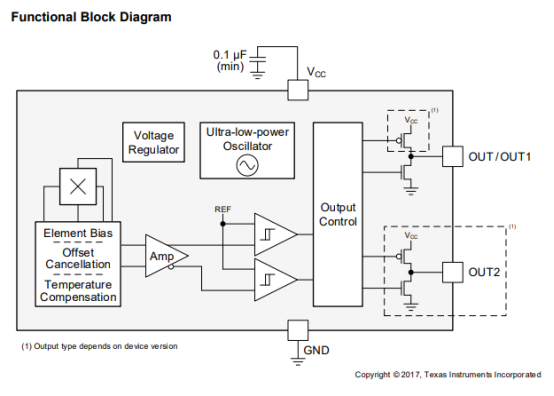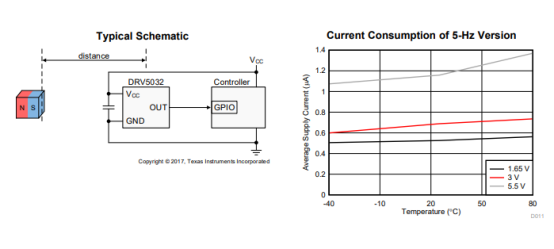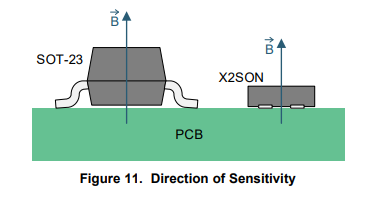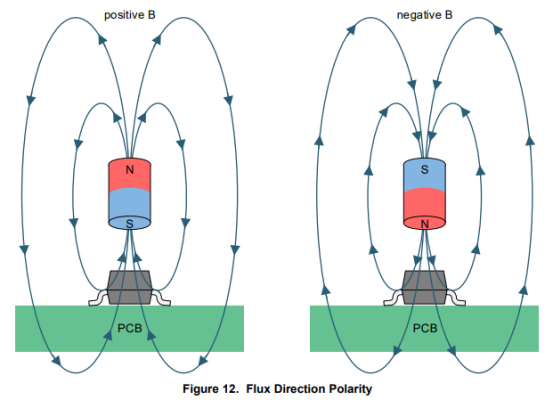Features
1• Industry-Leading Ultra-Low Power Consumption
– 5-Hz Version: 0.54 µA With 1.8 V
– 20-Hz Versions: 1.6 µA With 3 V
• 1.65- to 5.5-V Operating VCC Range
• Magnetic Threshold Options (Maximum BOP):
– 3.9 mT, Highest Sensitivity
– 4.8 mT, High Sensitivity
– 9.5 mT, Medium Sensitivity
– 63 mT, Lowest Sensitivity
• Omnipolar and Unipolar Options
• 20-Hz and 5-Hz Sampling Rate Options
• Open-Drain and Push-Pull Output Options
• SOT-23 and X2SON Package Options
• –40°C to +85°C Operating Temperature Range

Applications
• Battery-Critical Position Sensing
• Electricity Meter Tamper Detection
• Cell Phone, Laptop, or Tablet Case Sensing
• E-locks, Smoke Detectors, Appliances
• Medical Devices, IoT Systems
• Valve or Solenoid Position Detection
• Contactless Diagnostics or Activation
Description
The DRV5032 device is an ultra-low-power digitalswitch Hall effect sensor, designed for the most compact and battery-sensitive systems. The device is offered in multiple magnetic thresholds, sampling rates, output drivers, and packages to accommodate various applications. When the applied magnetic flux density exceeds the BOP threshold, the device outputs a low voltage. The output stays low until the flux density decreases to less than BRP, and then the output either drives a high voltage or becomes high impedance, depending on the device version. By incorporating an internal oscillator, the device samples the magnetic field and updates the output at a rate of 20 Hz, or 5 Hz for the lowest current consumption. Omnipolar and unipolar magnetic responses are available. The device operates from a VCC range of 1.65 V to 5.5 V, and is packaged in a standard SOT-23 and small X2SON.

Overview
The DRV5032 device is a magnetic sensor with a digital output that indicates when the magnetic flux density threshold has been crossed. The device integrates a Hall effect element, analog signal conditioning, and a lowfrequency oscillator that enables ultra-low average power consumption. By operating from a 1.65-V to 5.5-V supply, the device periodically measures magnetic flux density, updates the output, and enters a low-power sleep state.

Feature Description (continued)
Magnetic flux that travels from the bottom to the top of the package is considered positive in this data sheet. This condition exists when a south magnetic pole is near the top of the package. Magnetic flux that travels from the top to the bottom of the package results in negative millitesla values.

Magnetic Threshold:
Devices that have a lower magnetic threshold detect magnets at a farther distance. Higher thresholds generally require a closer distance or larger magnet.
Output Type
The DU, FA, FB, and FD device versions have push-pull CMOS outputs that can drive a VCC or ground level. The FC, AJ, and ZE device versions have open-drain outputs that can become high impedance or drive ground, and an external pullup resistor must be used.
Output Type Tradeoffs
The push-pull output allows for the lowest system power consumption, since there is no current leakage path when the output drives high or low. The open-drain output involves a leakage path when the output drives low, through the external pullup resistor. The open-drain outputs of multiple devices can be tied together to form a logical AND. In this setup, if any sensor drives low, the voltage on the shared node becomes low. This can allow a single GPIO to measure an array of sensors.
Detailed Design Procedure
A standard 2-pole magnet produces strong perpendicular flux components near the outer edges of the poles, and no perpendicular flux near the center at the north-south pole boundary. When the DRV5032FD is below the center of the magnet, it receives close to 0 mT, and both outputs drive high. If the switch with the embedded magnet moves left or right, the sensor receives a north or south field, and OUT1 or OUT2 drive low. This provides 3 digital states of detection. The length of the magnet should ideally be two times the distance of travel toward each side. Then, when the switch is pushed to either side, the outer edge of the magnet is positioned directly above the sensor where it applies the strongest perpendicular flux component. To determine the magnitude of magnetic flux density for a given magnet and distance, TI recommends using simulation software, testing with a linear Hall effect sensor, or testing with a gaussmeter.
Layout Guidelines
Magnetic fields pass through most nonferromagnetic materials with no significant disturbance. Embedding Hall effect sensors within plastic or aluminum enclosures and sensing magnets on the outside is common practice. Magnetic fields also easily pass through most printed-circuit boards, which makes placing the magnet on the opposite side possible.
